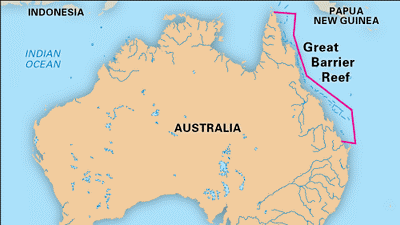Great Barrier Reef Faces Threats from Climate Change
Why in the news?
The Great Barrier Reef, a UNESCO World Heritage Site, faces growing threats from climate change, coral bleaching, pollution, and overfishing. Urgent global action is needed to preserve this irreplaceable ecosystem and its biodiversity.
The Great Barrier Reef: A Threatened Natural Wonder
- The Great Barrier Reef is the world’s largest living structure, spanning 350,000 square kilometers in the Coral Sea, off Australia’s northeastern coast.
- Recognized as a UNESCO World Heritage Site since 1981, it is an ecological marvel that plays a vital role in the health of marine ecosystems.
Biodiversity and Ecological Importance:
- The reef consists of nearly 3,000 individual reefs, including platform reefs, wall reefs, and fringing reefs along the coast.
- It supports 10% of the world’s coral reef ecosystems and hosts 400 coral species, 1,500 fish species, and 4,000 mollusk varieties.
- It provides habitat for endangered species, including the dugong and green turtle, and is a vital ecological hub in the Coral Sea.
Threats to the Reef:
- The Great Barrier Reef faces growing challenges due to climate change, rising sea temperatures, and coral bleaching.
- Pollution and overfishing also contribute to the reef’s degradation, making it vulnerable to long-term damage.
- Despite protection under the Great Barrier Reef Marine Park Authority, the reef’s future remains uncertain without urgent global action to address climate change and other human-driven threats.
Coral Reefs: Key Facts
- Definition: Marine ecosystems formed by coral polyps that have a symbiotic relationship with zooxanthellae (photosynthetic algae). The algae provide nutrients and oxygen, while corals offer shelter.
- Types of Corals:
- Hydrocorals (Fire Corals): Reef-building with hard exoskeletons and stinging cells.
- Octocorals (Soft Corals): Fleshy, non-skeletal corals like sea fans.
- Antipatharians (Black Corals): Dark-colored soft corals with chitin skeletons.
- Geographical Distribution: Found worldwide, but reef-building corals thrive in shallow, tropical or subtropical waters between 30° N and S latitudes. Major Indian reefs include Gulf of Mannar, Palk Bay, Gulf of Kachchh, Andaman & Nicobar, and Lakshadweep Islands.
- Importance:
- Cover 1% of oceans, but house 25% of marine species.
- Source of medicinal research for diseases like cancer and arthritis.
- Protect shorelines from waves and storms, contributing to beach formation.
- Essential for filtering toxins and supporting plant life that absorbs CO2.
- Coral Bleaching:
- Caused by stress factors like ocean temperature rise or pollution.
- Leads to the loss of algae, turning corals white and weakening them.
This natural wonder, visible from space, remains an irreplaceable part of Earth’s biodiversity. However, its survival depends on sustained conservation efforts and global commitment to reversing the damage caused by human activities.




